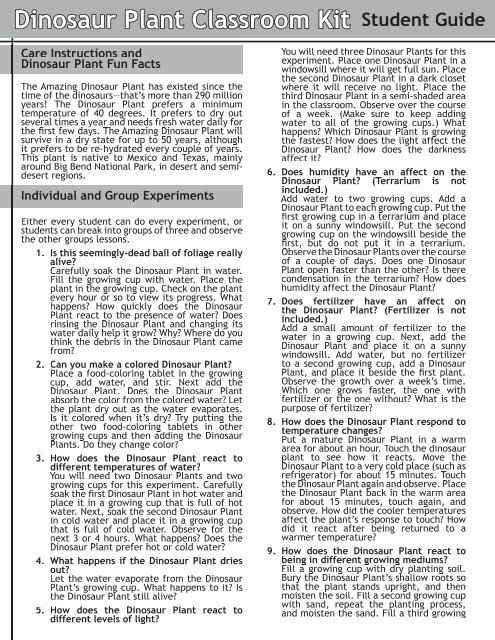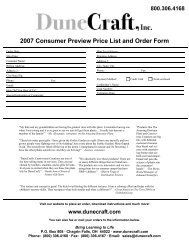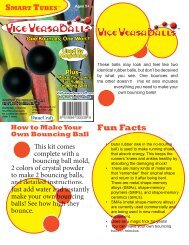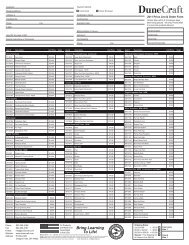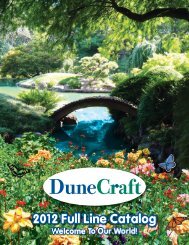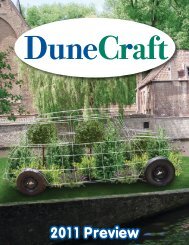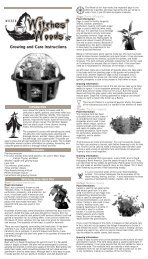Dinosaur Plant Student Guide - DuneCraft
Dinosaur Plant Student Guide - DuneCraft
Dinosaur Plant Student Guide - DuneCraft
You also want an ePaper? Increase the reach of your titles
YUMPU automatically turns print PDFs into web optimized ePapers that Google loves.
<strong>Dinosaur</strong> <strong>Plant</strong> Classroom Kit <strong>Student</strong> <strong>Guide</strong><br />
Care Instructions and<br />
<strong>Dinosaur</strong> <strong>Plant</strong> Fun Facts<br />
The Amazing <strong>Dinosaur</strong> <strong>Plant</strong> has existed since the<br />
time of the dinosaurs—that’s more than 290 million<br />
years! The <strong>Dinosaur</strong> <strong>Plant</strong> prefers a minimum<br />
temperature of 40 degrees. It prefers to dry out<br />
several times a year and needs fresh water daily for<br />
the first few days. The Amazing <strong>Dinosaur</strong> <strong>Plant</strong> will<br />
survive in a dry state for up to 50 years, although<br />
it prefers to be re-hydrated every couple of years.<br />
This plant is native to Mexico and Texas, mainly<br />
around Big Bend National Park, in desert and desert semi-<br />
regions.<br />
Individual and Group Experiments<br />
Either every student can do every experiment, or<br />
students can break into groups of three and observe<br />
the other groups lessons.<br />
1. Is this seemingly-dead ball of foliage really<br />
alive<br />
Carefully soak the <strong>Dinosaur</strong> <strong>Plant</strong> in water.<br />
Fill the growing cup with water. Place the<br />
plant in the growing cup. Check on the plant<br />
every hour or so to view its progress. What<br />
happens How quickly does the <strong>Dinosaur</strong><br />
<strong>Plant</strong> react to the presence of water Does<br />
rinsing the <strong>Dinosaur</strong> <strong>Plant</strong> and changing its<br />
water daily help it grow Why Where do you<br />
think the debris in the <strong>Dinosaur</strong> <strong>Plant</strong> came<br />
from<br />
2. Can you make a colored <strong>Dinosaur</strong> <strong>Plant</strong><br />
Place a food-coloring tablet in the growing<br />
cup, add water, and stir. Next add the<br />
<strong>Dinosaur</strong> <strong>Plant</strong>. Does the <strong>Dinosaur</strong> <strong>Plant</strong><br />
absorb the color from the colored water Let<br />
the plant dry out as the water evaporates.<br />
Is it colored when it’s dry Try putting the<br />
other two food-coloring tablets in other<br />
growing cups and then adding the <strong>Dinosaur</strong><br />
<strong>Plant</strong>s. Do they change color<br />
3. How does the <strong>Dinosaur</strong> <strong>Plant</strong> react to<br />
different temperatures of water<br />
You will need two <strong>Dinosaur</strong> <strong>Plant</strong>s and two<br />
growing cups for this experiment. Carefully<br />
soak the first <strong>Dinosaur</strong> <strong>Plant</strong> in hot water and<br />
place it in a growing cup that is full of hot<br />
water. Next, soak the second <strong>Dinosaur</strong> <strong>Plant</strong><br />
in cold water and place it in a growing cup<br />
that is full of cold water. Observe for the<br />
next 3 or 4 hours. What happens Does the<br />
<strong>Dinosaur</strong> <strong>Plant</strong> prefer hot or cold water<br />
4. What happens if the <strong>Dinosaur</strong> <strong>Plant</strong> dries<br />
out<br />
Let the water evaporate from the <strong>Dinosaur</strong><br />
<strong>Plant</strong>’s growing cup. What happens to it Is<br />
the <strong>Dinosaur</strong> <strong>Plant</strong> still alive<br />
5. How does the <strong>Dinosaur</strong> <strong>Plant</strong> react to<br />
different levels of light<br />
You will need three <strong>Dinosaur</strong> <strong>Plant</strong>s for this<br />
experiment. Place one <strong>Dinosaur</strong> <strong>Plant</strong> in a<br />
windowsill where it will get full sun. Place<br />
the second <strong>Dinosaur</strong> <strong>Plant</strong> in a dark closet<br />
where it will receive no light. Place the<br />
third <strong>Dinosaur</strong> <strong>Plant</strong> in a semi-shaded area<br />
in the classroom. Observe over the course<br />
of a week. (Make sure to keep adding<br />
water to all of the growing cups.) What<br />
happens Which <strong>Dinosaur</strong> <strong>Plant</strong> is growing<br />
the fastest How does the light affect the<br />
<strong>Dinosaur</strong> <strong>Plant</strong> How does the darkness<br />
affect it<br />
6. Does humidity have an affect on the<br />
<strong>Dinosaur</strong> <strong>Plant</strong> (Terrarium is not<br />
included.)<br />
Add water to two growing cups. Add a<br />
<strong>Dinosaur</strong> <strong>Plant</strong> to each growing cup. Put the<br />
first growing cup in a terrarium and place<br />
it on a sunny windowsill. Put the second<br />
growing cup on the windowsill beside the<br />
first, but do not put it in a terrarium.<br />
Observe the <strong>Dinosaur</strong> <strong>Plant</strong>s over the course<br />
of a couple of days. Does one <strong>Dinosaur</strong><br />
<strong>Plant</strong> open faster than the other Is there<br />
condensation in the terrarium How does<br />
humidity affect the <strong>Dinosaur</strong> <strong>Plant</strong><br />
7. Does fertilizer have an affect on<br />
the <strong>Dinosaur</strong> <strong>Plant</strong> (Fertilizer is not<br />
included.)<br />
Add a small amount of fertilizer to the<br />
water in a growing cup. Next, add the<br />
<strong>Dinosaur</strong> <strong>Plant</strong> and place it on a sunny<br />
windowsill. Add water, but no fertilizer<br />
to a second growing cup, add a <strong>Dinosaur</strong><br />
<strong>Plant</strong>, and place it beside the first plant.<br />
Observe the growth over a week’s time.<br />
Which one grows faster, the one with<br />
fertilizer or the one without What is the<br />
purpose of fertilizer<br />
8. How does the <strong>Dinosaur</strong> <strong>Plant</strong> respond to<br />
temperature changes<br />
Put a mature <strong>Dinosaur</strong> <strong>Plant</strong> in a warm<br />
area for about an hour. Touch the dinosaur<br />
plant to see how it reacts. Move the<br />
<strong>Dinosaur</strong> <strong>Plant</strong> to a very cold place (such as<br />
refrigerator) for about 15 minutes. Touch<br />
the <strong>Dinosaur</strong> <strong>Plant</strong> again and observe. Place<br />
the <strong>Dinosaur</strong> <strong>Plant</strong> back in the warm area<br />
for about 15 minutes, touch again, and<br />
observe. How did the cooler temperatures<br />
affect the plant’s response to touch How<br />
did it react after being returned to a<br />
warmer temperature<br />
9. How does the <strong>Dinosaur</strong> <strong>Plant</strong> react to<br />
being in different growing mediums<br />
Fill a growing cup with dry planting soil.<br />
Bury the <strong>Dinosaur</strong> <strong>Plant</strong>’s shallow roots so<br />
that the plant stands upright, and then<br />
moisten the soil. Fill a second growing cup<br />
with sand, repeat the planting process,<br />
and moisten the sand. Fill a third growing
<strong>Dinosaur</strong> <strong>Plant</strong> Classroom Kit <strong>Student</strong> <strong>Guide</strong><br />
cup with rocks and pebbles. Arrange them in<br />
a circle with a hole in the middle. Put the<br />
<strong>Dinosaur</strong> <strong>Plant</strong>’s roots in the middle of the<br />
rocks so that it stands upright, and add some<br />
water. Fill a fourth growing cup with just<br />
water and add the <strong>Dinosaur</strong> <strong>Plant</strong>. Observe<br />
over the next few hours. Which <strong>Dinosaur</strong><br />
<strong>Plant</strong> opens the fastest Which medium does<br />
it seem to prefer Why would the <strong>Dinosaur</strong><br />
<strong>Plant</strong> do better in one medium as opposed<br />
to another<br />
Discussion Questions<br />
What special uses could the Amazing <strong>Dinosaur</strong> <strong>Plant</strong><br />
have How could it be helpful to humans and our<br />
environment<br />
How much water does the <strong>Dinosaur</strong> <strong>Plant</strong> retains<br />
when it is dehydrated<br />
<strong>Dinosaur</strong> <strong>Plant</strong>s are said to resemble mosses. Can<br />
you explain how they might be more advanced than<br />
the common moss What is the difference between<br />
a vascular and nonvascular plant<br />
What is the difference between a dormant and<br />
an active plant Is the <strong>Dinosaur</strong> <strong>Plant</strong> dormant or<br />
active How is the <strong>Dinosaur</strong> <strong>Plant</strong> able to come back<br />
to life after it has been out of water for so long<br />
What adaptations have helped the <strong>Dinosaur</strong> <strong>Plant</strong><br />
survive for so long<br />
Can you explain what natural selection and<br />
evolution are How do these terms apply to the<br />
<strong>Dinosaur</strong> <strong>Plant</strong><br />
Notes<br />
©<strong>DuneCraft</strong>, Inc. 2006<br />
Chagrin Falls, Ohio 44022<br />
All Rights Reserved<br />
Made in the USA<br />
Visit www.dunecraft.com for more information


